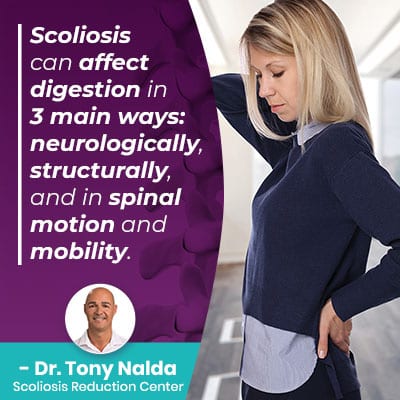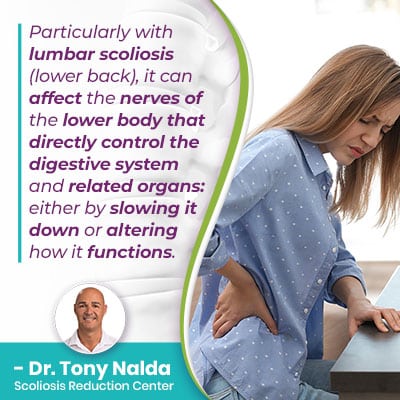How Does Scoliosis Affect The Digestive System? [ANSWERS]

Although scoliosis is a progressive and incurable spinal condition, it is highly treatable, and thanks to proactive treatment, increasing condition severity, and its related symptoms and complications can be prevented. Continue reading to find out how a spinal condition like scoliosis can affect the digestive system.
Although scoliosis is a spinal condition, its effects aren’t isolated to the back, and scoliosis progression can cause complications, such as digestive issues. Scoliosis can affect the digestive system in 3 main ways: neurologically, structurally, and in the spine’s motion and mobility.
Before getting to the specifics of how scoliosis can affect the digestive system, let’s first talk generally about the condition itself for a more comprehensive understanding of how it can affect the body in so many different ways.
Table of Contents
Understanding the Effects of Scoliosis
The spine doesn’t just provide the body with structure, movement, and allow us to stand upright. It also works in tandem with the brain to form the central nervous system (CNS).
The central nervous system facilitates brain-body communication, meaning the spine is involved in the function of virtually every working system within the body, which is why spinal conditions like scoliosis can have such widespread effects.
Scoliosis is the development of an unnatural sideways spinal curve, with rotation, and as the spine’s natural and healthy curves make it stronger, more flexible, and able to absorb stress like a coiled spring, a loss of one or more of those healthy curves can impact the spine’s overall health and function.
Scoliosis introduces a lot of uneven forces to the body, which is why one of its earliest symptoms and telltale signs in adolescents is postural deviation; the main symptom of scoliosis in adults is back or radicular pain.
As a result of the uneven forces, scoliosis can disrupt the body’s overall symmetry and cause:
- Uneven shoulders
- Uneven hips
- The Development of a rib arch
- An uneven waistline
- Arms and legs that appear to hang at different lengths
- Back or radicular pain (adult scoliosis)
- Ill-fitting clothing
- Changes to balance, coordination, and gait
Now, one of the most important condition variables, in terms of how it will affect the body, is condition severity, so let’s talk briefly about how scoliosis is classified in terms of severity.
Condition Severity
The complex nature of scoliosis necessitates a customized treatment approach, which is partly due to the wide severity spectrum that scoliosis features.
For a diagnosis of scoliosis to be reached, an unnatural sideways spinal curve, with rotation, and a minimum Cobb angle of 10 degrees, must be present.
Cobb angle is a measurement taken during X-ray that involves drawing intersecting lines from the tops and bottoms of the curve’s most-tilted vertebrae at its apex, and the resulting angle is expressed in degrees:
- Mild scoliosis: Cobb angle measurement of between 10 and 25 degrees
- Moderate scoliosis: Cobb angle measurement of between 25 and 40 degrees
- Severe scoliosis: Cobb angle measurement of 40+ degrees
- Very-severe scoliosis: Cobb angle measurement of 80+ degrees
Now, every case of scoliosis is unique, which is why there is no one-size-fits-all treatment plan that can be applied, and important variables that shape a patient’s experience of life with scoliosis include patient age, condition type (cause), curvature location, and condition severity.
Just because one patient experiences a certain symptom doesn’t mean another will, and condition severity is a large part of that.
Remember, as a progressive condition, scoliosis has it in its nature to worsen over time, particularly if left untreated or not treated proactively, so even if a person is diagnosed with mild scoliosis, it can easily progress to become moderate, severe, or very severe scoliosis.
 The higher the Cobb angle, the more out of alignment the spine is, the more uneven forces are exposed to the body, and the more likely symptoms are to be noticeable and complex.
The higher the Cobb angle, the more out of alignment the spine is, the more uneven forces are exposed to the body, and the more likely symptoms are to be noticeable and complex.
In addition, scoliosis tends to produce more noticeable and extreme symptoms once it becomes compressive in adulthood.
In children and adolescents, scoliosis is not a compressive condition, and that’s because a growing spine experiences a constant lengthening motion that counteracts the compressive force of the scoliotic curve.
Once skeletal maturity is reached, the spine and its surrounding muscles and nerves become vulnerable to compression, and this is when complications with the digestive system are most likely to develop.
Digestive issues are more commonly related to scoliosis in adults, so let’s now address the three main ways that scoliosis can affect the digestive system.
Scoliosis and the Digestive System
One of the most common questions I’m asked, especially by my adult patients who notice digestive changes as they age, is how scoliosis can factor into those digestive changes.
Scoliosis can affect digestion in 3 main ways: neurologically, structurally, and in spinal motion and mobility.
Neurological Effects
As mentioned, the brain and spine work in tandem to form the CNS, and the brain is the body’s message center, and through the spinal cord, those messages and signals are sent and received throughout the body, including its organs.
The spinal cord is protected by the spine the same way that the skull protects the brain; just as if the bones of the skull are to shift out of alignment, it can start to affect the brain’s internal function. The same can be said of the spine and spinal cord.
If the spine’s unnatural curve has affected the neurology of the spinal column-brain connection, it can also affect the organs it controls.
Nerves control organs, so if scoliosis-related nerve compression is affecting organ function, it can cause many effects.
Particularly with lumbar scoliosis (lower back), it can affect the nerves of the lower body that directly control the digestive system and related organs: either by slowing it down or altering how it functions.
Structural Effects
 What many people don’t understand is that as scoliosis progresses and becomes a compressive condition in adulthood, it can actually shorten torso length, and this can result in less room for the organs to work optimally within.
What many people don’t understand is that as scoliosis progresses and becomes a compressive condition in adulthood, it can actually shorten torso length, and this can result in less room for the organs to work optimally within.
As organs are muscles that have to move in a certain way, within a certain space, to move digestive food products through the entire body, the shortened distance of the torso can actually compress those organs needed for the digestive system to function as it is supposed to.
Spinal Motion and Mobility
We know that the spine is involved in the movement of food throughout the digestive system and in how organs related to digestion function.
As scoliosis progresses, the spine loses flexibility and becomes increasingly rigid, and this affects the way it moves and how organs around it can move.
The more a person can move their spine, the more they can move the tissue areas around the spine, so the more movement a scoliotic spine loses, which we know happens with progression; the more digestive patterns are affected.
This is just another benefit of being proactive with treatment and treating scoliosis while it’s mild, before progression has occurred that makes the spine more rigid, and less responsive to treatment, and before the body has had time to adjust to the unnatural spinal curve’s presence.
Conclusion
At first thought, it might not seem obvious that a spinal condition like scoliosis could affect the digestive system, but in light of how the spine and brain work together to form the central nervous system, which is involved in every working system within the body, the connection is clearer.
Just because a person has scoliosis doesn’t mean they are guaranteed to experience digestive issues, but particularly in adult scoliosis, once the condition becomes compressive, and as a condition progresses, it becomes more likely.
The three main ways scoliosis affects the digestive system are neurologically, structurally, and in spinal rigidity/range of motion.
Here at the Scoliosis Reduction Center, I address scoliosis symptoms, such as digestive issues, by treating their underlying cause: the condition itself.
By proactively working towards a curvature reduction, I can impact the condition on a structural level and prevent further progression, increasing condition severity, and the development of symptoms such as slower digestion and general changes to how the digestive system functions.
By reducing nerve pressure, improving torso length structurally, and increasing spinal flexibility and range of motion, related digestive issues are addressed as their underlying cause, and scoliosis itself is treated proactively through a variety of treatment forms.
Remember, just because scoliosis is a progressive condition doesn't mean we don’t know how to control its progressive nature and that even patients with mild scoliosis are bound to become severe; when responded to proactively, scoliosis can be highly treatable and its related symptoms and effects, such as digestive issues, can be minimized or eliminated.
Dr. Tony Nalda
DOCTOR OF CHIROPRACTIC
After receiving an undergraduate degree in psychology and his Doctorate of Chiropractic from Life University, Dr. Nalda settled in Celebration, Florida and proceeded to build one of Central Florida’s most successful chiropractic clinics.
His experience with patients suffering from scoliosis, and the confusion and frustration they faced, led him to seek a specialty in scoliosis care. In 2006 he completed his Intensive Care Certification from CLEAR Institute, a leading scoliosis educational and certification center.
About Dr. Tony Nalda
 Ready to explore scoliosis treatment? Contact Us Now
Ready to explore scoliosis treatment? Contact Us Now





